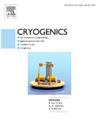极低温设备健康监测研究
IF 2.1
3区 工程技术
Q3 PHYSICS, APPLIED
引用次数: 0
摘要
极低温设备的全生命周期健康监测在很大程度上取决于核心结构材料的低温力学行为的稳定性。值得注意的是,Fe-Mn-C系列高锰钢是4.2 K极端低温场景的关键候选材料。为了解决该材料系统面临的三个关键挑战,即:本研究以Fe-22 wt% Mn-1 wt% C-0.3 wt% Cu高锰奥氏体钢为研究对象,对其4.2 K本构行为和微尺度变形机制进行了系统研究。结果表明:(1)在4.2 K时,材料在塑性阶段表现出“变周期、变振幅、变平衡位置”的锯齿形应力应变响应;这种行为主要是低频(60 Hz)动态应变时效(DSA)和机械孪晶的协同作用。(2) 4.2 k适应低温数字图像相关(DIC)技术显示,材料在不同温度范围内呈现出不同的应变分布,为健康监测中的风险区域定位提供了直接的视觉证据。(3)微观表征证实了4.2 K时的分层孪晶结构是维持材料强度塑性平衡的核心机制;在此基础上,建立了“宏观应变分布与微观孪晶演化”的关联模型。利用这些结果,本研究建立了一个包含dsa -孪生耦合项的基础4.2 K本构模型。该模型可为极低温设备健康监测中的“应力-应变-失效风险”分析提供定量支持,促进监测系统从“宏观评价”向“精准预警”推进。本文章由计算机程序翻译,如有差异,请以英文原文为准。
Research on health monitoring of extreme low-temperature equipment
Full-lifecycle health monitoring of extreme low-temperature equipment heavily depends on the stability of the cryogenic mechanical behavior of core structural materials. Notably, Fe-Mn-C series high-manganese steels stand as key candidate material for extreme low-temperature scenarios at 4.2 K. To address three critical challenges for this material system—i.e., the lack of 4.2 K constitutive models, multi-scale modeling bottlenecks, and insufficient local monitoring—that directly limit its health monitoring, this study targets Fe-22 wt% Mn-1 wt% C-0.3 wt% Cu high-manganese austenitic steel to systematically investigate its 4.2 K constitutive behavior and microscale deformation mechanisms. The results are as follows: (1) At 4.2 K, the material exhibits a serrated stress–strain response in the plastic stage, characterized by “variable period, amplitude, and equilibrium position”; this behavior is dominated by the synergy of low-frequency (<60 Hz) dynamic strain aging (DSA) and mechanical twinning. (2) 4.2 K-adapted cryogenic digital image correlation (DIC) technology reveals that the material exhibits differentiated strain distributions across temperature ranges, providing direct visual evidence for risk zone localization in health monitoring. (3) Microscopic characterization confirms that the hierarchical twin structure at 4.2 K is the core mechanism sustaining the material’s strength-plasticity balance; based on this, a correlation model linking “macroscopic strain distribution and microscopic twin evolution” is established. Leveraging these results, this study establishes a foundational 4.2 K constitutive model incorporating DSA-twinning coupling terms. This model enables quantitative support for “stress-strain-failure risk” analysis in extreme low-temperature equipment health monitoring, facilitating the advancement of monitoring systems from “macroscopic evaluation” to “precision early warning”.
求助全文
通过发布文献求助,成功后即可免费获取论文全文。
去求助
来源期刊

Cryogenics
物理-热力学
CiteScore
3.80
自引率
9.50%
发文量
0
审稿时长
2.1 months
期刊介绍:
Cryogenics is the world''s leading journal focusing on all aspects of cryoengineering and cryogenics. Papers published in Cryogenics cover a wide variety of subjects in low temperature engineering and research. Among the areas covered are:
- Applications of superconductivity: magnets, electronics, devices
- Superconductors and their properties
- Properties of materials: metals, alloys, composites, polymers, insulations
- New applications of cryogenic technology to processes, devices, machinery
- Refrigeration and liquefaction technology
- Thermodynamics
- Fluid properties and fluid mechanics
- Heat transfer
- Thermometry and measurement science
- Cryogenics in medicine
- Cryoelectronics
 求助内容:
求助内容: 应助结果提醒方式:
应助结果提醒方式:


